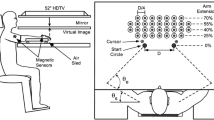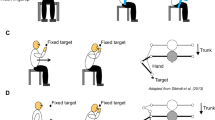Abstract
Consistent patterns of joint power underlie coordinated lower extremity behaviors such as running and walking. Recent work found that shoulder and elbow power consistently differed during reaching movements in the horizontal plane. Moreover, joint power during horizontal reaching appears correlated with motor cortical activity. It is not known if the feature of differential joint power extends to vertical plane reaches or to reaches of different movement conditions. The purpose of this study was to test for differential shoulder and elbow power during the acceleratory and deceleratory phases of fast and normal speed vertical reaches in sitting and supine positions. Our results suggest that shoulder and elbow power typically differed both within and across conditions. First, shoulder power values were positive or negative dependent largely on movement direction and movement phase. That is, for each direction and phase, the shoulder either generated or absorbed energy independent of speed or body position. Second, and unexpectedly, reaches of certain condition combinations had similar shoulder power magnitudes across directions. In contrast, elbow power values for each direction varied between positive and negative values depending on phase, speed and position, and no two condition combinations overlapped across directions. Third, as target direction, movement phase and body position varied, shoulder power at fast and normal speeds were linearly correlated, as was shoulder power in sitting and in supine. In contrast, elbow power was linearly correlated only between speeds. These results join other studies to suggest that the neuromotor control of the shoulder may be less complex as compared to the elbow as a general feature of reaching movements. This differential control has important implications for the study of reaching impairments in neurorehabilitation populations, and provides a potentially important variable in the study of cortical firing patterns.


Similar content being viewed by others
Notes
As is common in the center out task paradigm, a few targets can be reached with significant motion of only one joint. In this study, subjects produced single joint shoulder movements to target directions 60 and 210–240°. Elbow velocity during these movements was very low, resulting in low joint power across all condition combinations. Similarly, subjects produced single joint elbow movements to 90–120 and 270° and very low shoulder joint velocity and low shoulder joint power.
References
Bastian AJ, Martin TA, Keating JG and Thach WT (1996) Cerebellar ataxia: abnormal control of interaction torques across multiple joints. J Neurophys 76:492–509
Bastian AJ, Zackowski KM, Thach WT (2000) Cerebellar ataxia: torque deficiency or torque mismatch between joints? J Neurophysiol 83:3019–3030
Beer RF, Given JD, Dewald JP (1999) Task-dependent weakness at the elbow in patients with hemiparesis. Arch Phys Med Rehabil 80:766–772
Bianchi L, Angelini D, Orani GP, Lacquaniti F (1998) Kinematic coordination in human gait: relation to mechanical energy cost. J Neurophys 79:2155–2170
Cabel DW, Cisek P, Scott SH (2001) Neural activity in primary motor cortex related to mechanical loads applied to the shoulder and elbow during a postural task. J Neurophys 86:2102–2108
Dounskaia N, Ketcham CJ, Stelmach GE (2002) Commonalities and differences in control of various drawing movements. Exp Brain Res 146:11–25
Eng JJ, Winter DA (1995) Kinetic analysis of the lower limbs during walking: what information can be gained from a three-dimensional model? J Biomech 28:753–758
Eng JJ, Winter DA, Patla AE (1997) Intralimb dynamics simplify reactive control strategies during locomotion. J Biomech 30:581–588
Fisk J, Lackner JR, DiZio P (1993) Gravitoinertial force level influences arm movement control. J Neurophys 69:504–511
Galloway JC, Koshland GF (2002) General coordination of shoulder, elbow and wrist dynamics during multijoint arm movements. Exp Brain Res 142:163–180
Galloway JC, Bhat A, Heathcock J, Manal K, Lobo M (2001) Shoulder and elbow dynamics during vertical arm movements of various directions and speeds: Implications for development. Soc Neurosci Abstracts
Graham KM, Moore KD, Cabel DW, Gribble PL, Cisek P, Scott SH (2003) Kinematics and kinetics of multi-joint reaching in non-human primates. J Neurophys 89:2667–2677
Gribble PL, Scott SH (2002) Overlap of internal models in motor cortex for mechanical loads during reaching. Nature 417:938–941
Guo LY, Su FC, Wu HW, An KN (2003) Mechanical energy and power flow of the upper extremity in manual wheelchair propulsion. Clin Biomech 18:106–114
Hall CD, Jensen JL (2002) Age-related differences in lower extremity power after support surface perturbations. J Amer Geriatrics Soc 50:1782–1788
Hatzitaki V, Hoshizaki TB (1998) Dynamic joint analysis as a method to document coordination disabilities associated with Parkinson’s disease. Clin Biomech 13:182–189
Kalaska JF, Scott SH, Cisek P, Sergio LE (1997) Cortical control of reaching movements. Curr Opin Neurobiol 7:849–859
Kawato M (1999) Internal models for motor control and trajectory planning. Curr Opin Neurobiol 9:718–727
Kerrigan DC, Karvosky ME, Riley PO (2001) Spastic paretic stiff-legged gait: joint kinetics. APMR 80:244–249
Konczak J, Dichgans J (1997) The development toward stereotypic arm kinematics during reaching in the first 3 years of life. Exp Brain Res 117:346–354
Malfait N, Shiller DM, Ostry DJ (2002) Transfer of motor learning across arm configurations. J Neurosci 22:9656–9660
McFadyen BJ, Malouin F, Dumas F (2001) Anticipatory locomotor control for obstacle avoidance in mid-childhood aged children. Gait Posture 13:7–16
McGibbon CA, Krebs DE (2001) Age-related changes in lower trunk coordination and energy transfer during gait. J Neurophys 85:1923–1931
Papaxanthis C, Pozzo T, Popov KE, McIntyre J (1998) Hand trajectories of vertical arm movements in one-G and zero-G environments. Evidence for a central representation of gravitational force. Exp Brain Res 120:496–502
Patla AE, Prentice SD (1995) The role of active forces and intersegmental dynamics in the control of limb trajectory over obstacles during locomotion in humans. Exp Brain Res 106:499–504
Perell KL, Gregor RJ, Scremin AME (1998) Lower limb cycling mechanics in subjects with unilateral cerebrovascular accidents. J Appl Biomech 14:158–179
Robertson DGE, Winter DA (1980) Mechanical energy generation, absorption, and transfer amongst segments during walking. J Biomech 13:845–854
Rodgers MM, McQuade KJ, Rasch EK, Keyser RE, Finley MA (2003) Upper-limb fatigue-related joint power shifts in experienced wheelchair users and nonwheelchair users. J Rehab Res Dev 40:27–38
Rozendaal LA, Veeger HE, van der Woude LH (2003) The push force pattern in manual wheelchair propulsion as a balance between cost and effect. J Biomech 36:239–247
Schneider K, Hart T, Zernicke RF, Setoguchi Y, Oppenheim W (1993) Dynamics of below-knee child amputee gait: SACH foot versus Flex foot. J Biomech 26:1191–1204
Scott SH, Gribble PL, Graham KM, Cabel DW (2001) Dissociation between hand motion and population vectors from neural activity in motor cortex. Nature 413:161–165
Shadmehr R, Mussa-Ivaldi FA (1994) Adaptive representation of dynamics during learning of a motor task. J Neurosci 14:3208–3224
Thoroughman KA, Shadmehr R (1999) Electromyographic correlates of learning an internal model of reaching movements. J Neurosci 19:8573–8588
van der Helm FC, Veeger HE (1996) Quasi-static analysis of muscle forces in the shoulder mechanism during wheelchair propulsion. J Biomech 29:39–52
Winter DA (1983) Moments of force and mechanical power in jogging. J Biomech 16:91–97
Winter DA (1990) Biomechanics and motor control of human movement. Wiley, New York, pp 103–138
Winter DA, Robertson DGE (1978) Joint torque and energy patterns in normal gait. Biol Cybern 29:137–142
Wolpert DM, Ghahramani Z, Jordan MI (1995) An internal model for sensorimotor integration. Science 269:1880–1882
Acknowledgements
We thank Drs. Gail Koshland and John Scholz, and one anonymous reviewer for their helpful comments. This project was supported, in part, by a UNIDEL grant and a Research Foundation award from the University of Delaware to J.G. and Foundation for Physical Therapy award to J.H.
Author information
Authors and Affiliations
Corresponding author
Rights and permissions
About this article
Cite this article
Galloway, J.C., Bhat, A., Heathcock, J.C. et al. Shoulder and elbow joint power differ as a general feature of vertical arm movements. Exp Brain Res 157, 391–396 (2004). https://doi.org/10.1007/s00221-004-1955-5
Received:
Accepted:
Published:
Issue Date:
DOI: https://doi.org/10.1007/s00221-004-1955-5




